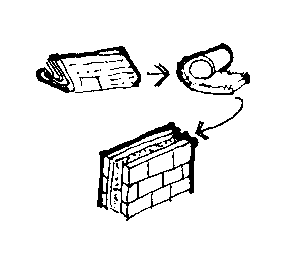| Materials
Design Considerations:
Natural materials- Specify lumber from certified, well-managed
forests. Plastered straw bales are a natural alternative to CMUs. Clay and mud
adobe brick insulate exceptionally well. Local stone and brick from the area are an
option.
Recyclability- Take advantage of recycled products currently on
the market, such as cement from fly ash, pipes from recycled plastic or metal, landscape
timber from recycled fiberglass, and roof shingles from recycled plastic.
Renewability- Make sure the materials which comprise the
exterior wall can be reused, once the building is demolished. Wood will decompose
before stone if it is not properly maintained. Stone and brick from an exterior wall
can be used as pavers.
Local materials- Contact local manufacturers to see what
products are available.
Non-toxic/ low toxicity- Refer to manufacturer product data
sheets to find any toxins. If you have questions, consult a chemist.
Harmony with environment- To ensure your exterior building
materials do not change the surrounding natural environment, test materials for any
run-off or emission capabilities.
Tools:
Case Studies to research:
Natural materials-
Boyne River Ecology Centre, Shelbourne, Ontario
Douglas B. Pollard Architects
Recyclability-
The Body Shop, Raleigh, NC
Design Harmony Inc.
(reused and recycled existing site and building materials, such as window, foundations,
exterior concrete wall panels, lighting and HVAC units)
Renewability-
The Energy Resource Center, Southern California Gas Company, Downey, CA
WLC Architects, Rancho Cucamonga, CA.
(60% of old building materials were either left in place, removed for future
reinstallation or recycled.)
Local materials-
Herman Miller SQA Facility, Zeeland, MI
William McDonough + Partners (local or regional materials and products that were
produced with sustaining and healthful methodologies were sought out and installed.)
Non-toxic/ low toxicity-
The National Audubon Society Headquarters, New York, New York
Croxton Collaborative Associates
(the minimization of toxic content of products and materials was the primary objective).
Harmony with environment-
Paulk Residence, Seabeck, WA
James Cutler Architects
(no synthetic materials were used, except for a vinyl tile in the bathroom. All
materials were locally grown, fabricated and galvanized)
Further Information:
“Centre of the Earth” May, Vernon. Architecture. Vol. 83, no.6, June 1993,
pp. 52-57.
EPA / DOE Energy Star Program
Moore, F. Environmental Control Systems: Heating, Lighting, Cooling. New
York: McGraw-Hill, Inc, 1993.
The Ecology of Architecture: A Complete Guide to Creating the Environmentally
Conscious Building by Laura Zeiher.
Roy, Rob. Super Insulated Houses and Underground Houses. New York:
Sterling Publishing, 1994.
National Audubon Society Audubon House: Building the Environmentally Responsible,
Energy-Efficient Office. New York, NY: John Wiley and Sons, Inc. 1994.
AIA Environmental Resource Guide, 1735 New York Ave., NW, Washington, DC 20002;
202.626.7508. Quarterly newsletter.
Building With Nature, P.O. Box 369, Gualala, CA 95445; 707.884.4513.
Bimonthly newsletter.
Environmental Building News, RR.1, Box 161, Brattleboro, VT 05301; 802.257.7300.
Bimonthly newsletter.
Guide to Resource Efficient Building Elements, P.O. Box 3866, Missoula, MT 59806;
Directory.
The Harris Directory, Stafford-Harris, Inc., 1916 Pike Place, #705, Seattle, WA 98101;
Computer database.
REDI Guide, Iris Communications, Inc., 258 East 10th Ave., Suite E, Eugene, OR 97401;
503.484.8935. Computer database.
Nontoxic Environments Inc., 6135 NW Mountain View Drive, Corvallis, OR 97330;
Catalog.
Shelter Supply Inc., 1325 East 79th St., Minneapolis, MN 55425; 800.762.8399. Catalog.
The Sourcebook for Sustainable Design, Boston Society of Architects, 52 Broad St.,
Boston, MA 02109; 617.951.0845. Catalog.
U.S. Green Building Council, 1615 Street NW, Suite 1200, Washington, DC 20036; Nonprofit
organization.
The Straw Bale House by Athena Steen, Bill Steen & David Bainbridge, from
Chelsea Green Publishing is the best source of information for straw-bale
construction. |
|
